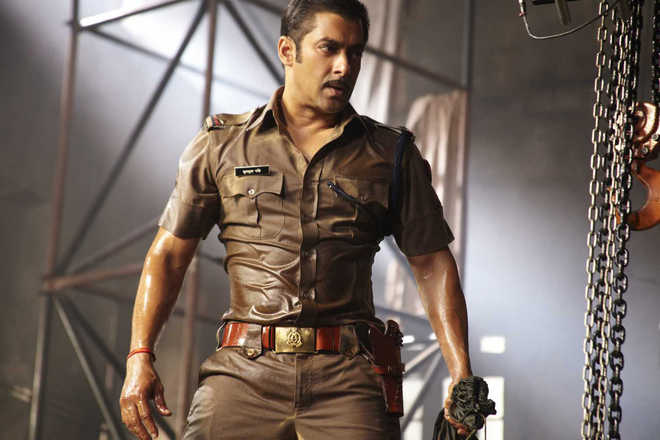
Cracker of a line: In Dabangg, Salman Khan’s several one-liners got the film many an applause from the audience.
Shardul Bhardwaj
Whether it is an ATM line or a hospital OPD, it is not uncommon to hear someone quip Amitabh Bachchan’s dialogue from his film Kaalia (1981): ‘Hum jahaan khade hote hain, line wahin se shuru hoti hai’. Bollywood film dialogues have had a considerable influence on how we speak and consequently on how we understand the multiple cultures of our country. As an example, Bollywood films predispose us to imagine Sikhs not speaking any language other than Punjabi or living in any part of the world except Punjab, Canada or Delhi. For a large part of the population born in northern India after the 1950s, these dialogues have served to be the maxims, norms and in some cases dictums to be followed in life.
Dialogue writers like Salim Khan have been big names, as the dialogues of a film have been as much a selling point as the movie stars and item songs in a Bollywood film. Often, though, this very idea of dialoguebaazi and smart one-liners seem to be dragging a film down. A tried-and-tested formula for commercial success, which was modified by Anurag Kashyap in his films like Gangs of Wasseypur, has made apparent the glaring inefficacy of dialogue writing in Bollywood.
Why has this happened? Does it not seem odd when Akshaye Khanna (in Ittefaq, 2017) in an interrogation cell resorts to witty remarks? Or the awkwardness of the situation when Salman Khan does it midway through a fight scene in Dabangg (2010)? Up till now, through the 1970s, 1980s, 1990s and early 2000s, heroes have been given smart one-liners to ride over a situation.
An initial reason could be that the film was in a confused space in terms of the direction it wanted to take. Posing as a modern Mumbai Noir at the beginning, it is advertised relentlessly as a ‘thriller’. Within this, there is an attempt on part of the makers to make their characters real, but simultaneously strain them with stylised dialogues. One jovial character’s utterance of lines, which seem funny because these are out of place can be considered characterisation, but each character fighting for the smartest and funniest dialogue is simply chaos.
The function and aesthetics of Bollywood were, until recently, ornamental, but today filmmakers are claiming to make a shift towards realism. There is a considerable increase in the number of films which try to undercut the classic stylisation of a semi-Bollywood musical. In such a scenario, the showy nature of dialoguebaazi is becoming obsolete.
Many eminent filmmakers like Shahji Karun have called dialogues a mere illustration. The actor and the tone of a film have to be in the right space for the dialogues to be effective. Some filmmakers do not even write their dialogues, they construct a situation, and with the help of workshops and discussions, let their actors improvise on set. Hence, those like Alejandro Innaritu can extract some of the most real performances from their actors.
Writing a dialogue at one’s table in the confines of a room is an enormously difficult task. Language, in its spoken and written form, is vastly different, even if making the written dialogue conversational. One dialogue writer cannot always place himself in the shoes of various diverse characters of a film, and write for each one of them. While this may work in the written medium by itself, it can go in various different directions once an actor is expected to give life to these dialogues. An actor’s interpretation informed by the script and the director’s intentions is as real as a dialogue can get, because dialogue in essence is an interchange, a reaction to the stimulus of an action. To replace the individuality of each character as well as the actor with the humdrum of a singular imagination in the film’s world amounts to an injustice to the real world of the actor and audience. Which is what some Bollywood films like Ittefaq end up conveying.
In this fixation on delivering the wittiest possible dialogue without regard for the requirements of a particular situation, place and moment in time, ultimately only stereotypes remain. The most unreal trait after smart one liners in today’s popular Hindi cinema dialogue writing are the impossibly complete sentences that the characters give vent to in the most emotionally tasking of moments — be it angst, ecstasy or even in a state of extreme injury. For Hindi cinema to become as real as it aspires to be, the ideas about dialogue writing will have to change so that characters may start speaking like people instead of their caricatures.



























